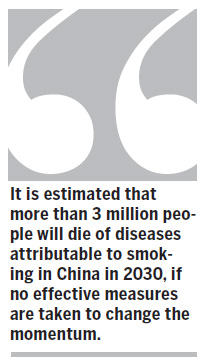View
Tobacco control necessary
By Li Yang (China Daily)
Updated: 2011-01-10 08:04
 |
Large Medium Small |

More must be done to meet the obligations of the WHO Framework Convention and reduce secondhand smoking
Sunday marked the fifth anniversary of China's ratification of the WHO Framework Convention on Tobacco Control. The treaty requires a comprehensive ban on tobacco advertising, promotion and sponsorship, and prohibits smoking in the workplace and public places. But China has failed to meet the goals it agreed to. China is the world's largest producer and consumer of tobacco. It is estimated that approximately one in every three cigarettes smoked globally is made and consumed in China.
Rule of law sets the binding framework for all campaigns to curb tobacco consumption in China. It is the government's obligation to provide public services to prevent tobacco hazards, said Ma Huaide, vice-president of China University of Political Science and Law.
Stronger tobacco control measures must be meted out, including a complete ban on promotion and sponsorship, smoking in public places and a tax policy to raise retail prices and make cigarettes less affordable to the young.
The country has seen a 40 percent increase in tobacco output during the past five years, according to Tobacco Control and China's Future, an evaluation report by Yang Gonghuan, vice-director of the China Center for Disease Control and Prevention and Hu Angang, director of the Research Center for Contemporary China at Tsinghua University.
Yang and Hu's report concludes that the administrative mechanism of the tobacco industry should be reformed and the government's role in comprehensive tobacco control should be clearly defined.
The responsibility of tobacco control should not be put in the hands of government agencies that also oversee the tobacco industry.
"The interests and objective of tobacco control are dramatically opposed to those of the tobacco industry, illustrated by the English expression, 'having the fox guard and chicken coop'," says Jeffery P. Koplan, director of Emory Global Health Institute, Emory University.
The tobacco industry and its related interest groups have launched many counter-tobacco control activities. These include, denying the scientific conclusions on the health hazards of smoking and claiming smoking is a person's right.
Yang said that the powerful industry uses a "low tar and low harm" marketing strategy to mislead the public. It also encourages tobacco consumption through disguised advertising, sponsorship and promotion.
As a result, Yang's surveys indicate there were an estimated 300 million smokers in China in 2010 and 740 million nonsmokers suffering from exposure to secondhand smoke, especially in public places and workplaces.
The number of deaths attributed to tobacco use has increased rapidly since 2000 in China and reached 1.2 million in 2005.
Tobacco-attributable deaths will continue to increase quickly, the peak will coincide with the end of China's "population bonus" period in the next 20 years. It is estimated that more than 3 million people will die of diseases attributable to smoking in China in 2030, if no effective measures are taken to change the momentum.
Moreover, tobacco companies continue to circumvent advertising and sponsorship bans. Chinese citizens still do not fully understand the personal health consequences of tobacco use, which means public education is badly needed.
Deeply engrained cultural practices such as gifting-giving of cigarettes, for example, which perpetuate tobacco use should be countered with public education campaigns that demonstrate how such behavior harms people.
People may argue that the tobacco industry pays 6 percent of the government's tax revenue and employs 20 million tobacco planters and 250,000 workers. But an integrated analysis indicates that the benefits of the industry are mitigated by tobacco-related medical expenditure and loss of productivity, which are increasing at an explosive rate.
Tax is a practical way to contain tobacco production and consumption. But according to a 2008 WHO survey, the proportion of tax in cigarette prices varies among different countries, for instance, 80 percent in the United Kingdom, 76 percent in Germany, 58 percent in Brazil, 54 percent in India and only 37 percent in China.
Yang and Hu's research suggests that even an increase of 1 yuan in the price of lower-end cigarettes would result in a tangible reduction in the number of smokers.
Any change in overall smoking demand and supply takes a long time, which provides a golden opportunity for the Chinese tobacco industry to transform its structure and redefine its role.
Vice-Chairman of the Standing Committee of the National People's Congress Han Qide says: "I think the stance we take in tobacco control immediately demonstrates if our development is for the people's interest or not. It is my sincere wish that the tobacco control project in China can make some breakthrough progress in the next five years."
The author is a reporter with China Daily.